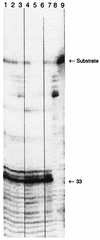Dicaffeoylquinic and dicaffeoyltartaric acids are selective inhibitors of human immunodeficiency virus type 1 integrase
- PMID: 9449274
- PMCID: PMC105469
- DOI: 10.1128/AAC.42.1.140
Dicaffeoylquinic and dicaffeoyltartaric acids are selective inhibitors of human immunodeficiency virus type 1 integrase
Abstract
Current pharmacological agents for human immunodeficiency virus (HIV) infection include drugs targeted against HIV reverse transcriptase and HIV protease. An understudied therapeutic target is HIV integrase, an essential enzyme that mediates integration of the HIV genome into the host chromosome. The dicaffeoylquinic acids (DCQAs) and the dicaffeoyltartaric acids (DCTAs) have potent activity against HIV integrase in vitro and prevent HIV replication in tissue culture. However, their specificity against HIV integrase in cell culture has been questioned. Thus, the ability of the DCQAs and DCTAs to inhibit binding of HIV type 1 (HIV-1) gp120 to CD4 and their activities against HIV-1 reverse transcriptase and HIV RNase H were studied. The DCQAs and DCTAs inhibited HIV-1 integrase at concentrations between 150 and 840 nM. They inhibited HIV replication at concentrations between 2 and 12 microM. Their activity against reverse transcriptase ranged from 7 microM to greater than 100 microM. Concentrations that inhibited gp120 binding to CD4 exceeded 80 microM. None of the compounds blocked HIV-1 RNase H by 50% at concentrations exceeding 80 microM. Furthermore, when the effects of the DCTAs on reverse transcription in acutely infected cells were measured, they were found to have no activity. Therefore, the DCQAs and DCTAs exhibit > 10- to > 100-fold specificity for HIV integrase, and their activity against integrase in biochemical assays is consistent with their observed anti-HIV activity in tissue culture. Thus, the DCQAs and DCTAs are a potentially important class of HIV inhibitors that act at a site distinct from that of current HIV therapeutic agents.
Figures


Similar articles
-
Structure-activity relationships: analogues of the dicaffeoylquinic and dicaffeoyltartaric acids as potent inhibitors of human immunodeficiency virus type 1 integrase and replication.J Med Chem. 1999 Feb 11;42(3):497-509. doi: 10.1021/jm9804735. J Med Chem. 1999. PMID: 9986720
-
Irreversible inhibition of human immunodeficiency virus type 1 integrase by dicaffeoylquinic acids.J Virol. 1999 Apr;73(4):3309-16. doi: 10.1128/JVI.73.4.3309-3316.1999. J Virol. 1999. PMID: 10074185 Free PMC article.
-
Dicaffeoyltartaric acid analogues inhibit human immunodeficiency virus type 1 (HIV-1) integrase and HIV-1 replication at nontoxic concentrations.J Med Chem. 2002 Aug 15;45(17):3669-83. doi: 10.1021/jm010359d. J Med Chem. 2002. PMID: 12166940
-
Structure-activity relationships of HIV-1 integrase inhibitors--enzyme-ligand interactions.Curr Med Chem. 2003 Sep;10(18):1795-810. doi: 10.2174/0929867033456981. Curr Med Chem. 2003. PMID: 12871105 Review.
-
HIV-1 integrase: a target for new AIDS chemotherapeutics.Curr Top Med Chem. 2004;4(9):979-90. doi: 10.2174/1568026043388448. Curr Top Med Chem. 2004. PMID: 15134552 Review.
Cited by
-
Preparation of Fe3O4@SW-MIL-101-NH2 for selective pre-concentration of chlorogenic acid metabolites in rat plasma, urine, and feces samples.J Pharm Anal. 2022 Aug;12(4):617-626. doi: 10.1016/j.jpha.2022.01.002. Epub 2022 Jan 31. J Pharm Anal. 2022. PMID: 36105170 Free PMC article.
-
Isolation and functional characterization of a cDNA coding a hydroxycinnamoyltransferase involved in phenylpropanoid biosynthesis in Cynara cardunculus L.BMC Plant Biol. 2007 Mar 20;7:14. doi: 10.1186/1471-2229-7-14. BMC Plant Biol. 2007. PMID: 17374149 Free PMC article.
-
Isolation of 4,5-O-Dicaffeoylquinic Acid as a Pigmentation Inhibitor Occurring in Artemisia capillaris Thunberg and Its Validation In Vivo.Evid Based Complement Alternat Med. 2016;2016:7823541. doi: 10.1155/2016/7823541. Epub 2016 Jul 26. Evid Based Complement Alternat Med. 2016. PMID: 27528883 Free PMC article.
-
Echinacea purpurea (L.) Moench: Biological and Pharmacological Properties. A Review.Plants (Basel). 2022 May 5;11(9):1244. doi: 10.3390/plants11091244. Plants (Basel). 2022. PMID: 35567246 Free PMC article. Review.
-
Genetic mapping and annotation of genomic microsatellites isolated from globe artichoke.Theor Appl Genet. 2009 May;118(8):1573-87. doi: 10.1007/s00122-009-1005-6. Epub 2009 Mar 27. Theor Appl Genet. 2009. PMID: 19326092
References
-
- Aboulker J, Swart A M. Preliminary analysis of the Concorde trial. Lancet. 1993;341:889–890. - PubMed
-
- Baldwin E T, Bhat T N, Liu B, Pattabiraman N, Erickson J W. Structural basis of drug resistance for the V82A mutant of HIV-1 proteinase. Nat Struct Biol. 1995;2:244–249. - PubMed
-
- Brinkworth R I, Fairlie D P. Non-peptidic anti-AIDS agents: inhibition of HIV-1 proteinase by disulfonates. Biochem Biophys Res Commun. 1992;188:624–630. - PubMed
-
- Brinkworth R I, Woon T C, Fairlie D P. Inhibition of HIV-1 proteinase by non-peptide carboxylates. Biochem Biophys Res Commun. 1991;176:241–246. - PubMed
Publication types
MeSH terms
Substances
Grants and funding
LinkOut - more resources
Full Text Sources
Other Literature Sources
Research Materials

